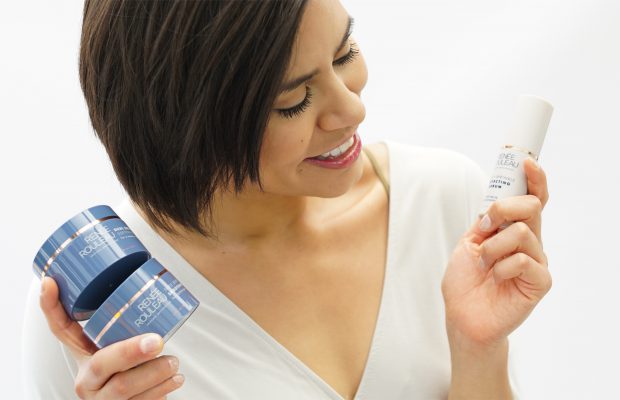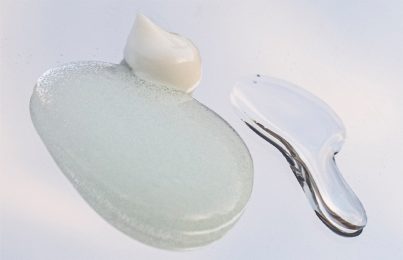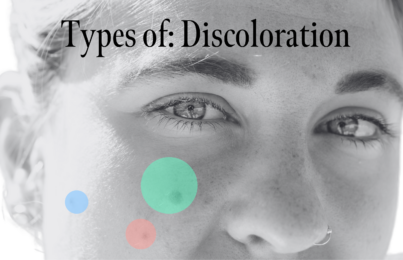Updated 09/19/25. Before we talk about the different types of exfoliants and how often you should be using them, we first have to define the word itself. In basic terms, an exfoliant is anything that removes dead cells from the surface of the skin, revealing a clearer, smoother, and more even-toned complexion underneath. Exfoliants can offer both immediate and long-term benefits, from unclogging pores and fading post-breakout marks to lessening dryness and improving the appearance of discoloration.
However, with so many different types of exfoliants and the various forms in which they come, it can be difficult to determine which one is best for your skin. It can also be difficult to determine how much is too much. Keep scrolling to see my ultimate guide to exfoliation and learn how to exfoliate your face without overdoing it.
A Quick History of My Own Experience with Exfoliants
Back in the ’80s, when I was a teenager, I scrubbed my skin with a Buff Puff (who remembers those?). I use the word “scrubbed,” because the word “exfoliant” or “exfoliation” wasn’t even used in the skincare world yet!
I would apply a high-foaming face wash and then go to town scrubbing with the Buff Puff. With blemish-prone skin, scrubbing seemed like a good idea at the time. As you can imagine, my young, sensitive skin wasn’t happy; it only became more irritated.
In 1992, I got my hands on a pure, 20% AHA glycolic acid gel. This was revolutionary at the time because these acids were fairly unknown (even among skincare professionals!). I’ll never forget the first time I used it. I knew it was strong because it began to tingle on my skin. Per the instructions, I kept it on my skin for 10 minutes, rinsed it off, then wiped my face with a damp washcloth. As I wiped, I noticed my skin was peeling off. I was excited, thinking it was just really effective. Come to find out, I was actually wiping off new skin cells.
Once dry, my skin began oozing badly. I developed scabs all over my face, and it took months to fade the resulting discoloration. It was a nightmare—especially since I was an esthetician, and I was expected to have perfect skin. If there was one silver lining from that experience, it was that I learned what NOT to do. I still use exfoliating acids to this day, and I’ve never repeated that experience.
Exfoliating Acids
How They Work
There are two categories of exfoliating acids: Alpha Hydroxy Acids (AHAs) and Beta Hydroxy Acids (BHAs). Both create a chemical reaction that lowers the skin’s pH and dissolves and digests the “glue” that holds expired skin cells together. To work most effectively at home, an exfoliating acid must fall within a pH of 3-4 and be at a concentration of 5%-20%.
AHAs are water-soluble, so they don’t penetrate as far into the pores as BHAs. However, they can be incredibly effective at removing pigmented cells left behind by breakouts or sun exposure, as well as smoothing texture. The most common AHAs are lactic, glycolic, malic, mandelic, and tartaric acids. (Citric acid is also an AHA, but it’s not technically an exfoliant; it is used as a pH adjuster.)
BHAs, on the other hand, are oil-soluble, so they can penetrate deep into the pores to prevent clogging and remove dead cells that can lead to blackheads and breakouts. There are two BHAs commonly found in skincare: salicylic acid and betaine salicylate. Another one, called butyric acid, is found in the odor that rancid butter emits, so it’s not something you would want to use on your skin! That’s just a fun little fact I learned from a cosmetic chemistry class I took at UCLA.
Note: If you’re pregnant, consult your doctor before using BHAs.
Who They Suit
Exfoliating acids suit anyone who has clogged pores, blackheads, breakouts, dryness, flakiness, fine lines, wrinkles, large pores, dullness, discoloration, or rough texture. Anyone can safely use exfoliating acids—even those who have sensitive skin!
What I love most about exfoliating acids is that they do the work for you. In other words, you don’t have to rub the skin. As long as you’re using a formula with a proper pH and percentage that is appropriate for your skin type, you can let it work its magic with no effort on your part.
Note: A tingling sensation may or may not occur when you apply an exfoliating acid. This is not an indicator of efficacy. Instead, it’s an indicator of how your skin’s barrier is acting at the time of use. If your skin tingles, it could mean your barrier is compromised. (Read up on how to fix a damaged moisture barrier). It’s very common for the tingling sensation to stop after a month or so of use. People say, “I don’t feel like it’s working anymore because I can’t feel it sting like I did when I first started using it.” The truth is exfoliating acids, when not overused, can actually aid in fixing your skin’s moisture barrier!
Where You Can Find Them
You can find exfoliating acids in all sorts of skincare products, ranging from cleansers and toners to serums, creams, and masks. Some of my favorite exfoliating acid products are the AHA/BHA Blemish Control Cleanser, the Pro Results Power Serum, and the Pore + Wrinkle Perfecting Serum. The first one combines AHAs and BHAs with enzymes and jojoba esters for thorough exfoliation and blemish prevention. The second contains a powerful blend of glycolic, lactic, and mandelic acids to improve the appearance of sun damage. Finally, the third is perfect for anyone who struggled with breakouts and signs of aging, since it contains lactic, glycolic, and salicylic acids.
Exfoliating Enzymes
How They Work
Enzymes are fruit-derived. They contain no acids or grains. This means they can offer a gentler, no-sting exfoliation, which is very helpful for sensitive skin types. Pineapple, pumpkin, pomegranate, and papaya are the most common fruit enzymes used in skincare products. They work by dissolving and digesting the protein found in dead skin cells, thereby revealing smoother skin.
Both exfoliating acids and exfoliating enzymes dissolve dry skin cells, but there are a few main differences in how they work. Enzymes work more on the surface, while acids slip deeper into the skin’s surface. Also, enzymes are activated by water and work more slowly to digest cellular buildup. Apply them to damp skin and leave them on for anywhere from 15 to 20 minutes. When used in a peel, they can work in as little as five minutes.
Who They Suit
Any kind of exfoliation can improve clogged pores, blackheads, blemishes, dryness, flakiness, fine lines, wrinkles, large pores, dullness, and discoloration. With that being said, anyone who can’t tolerate exfoliating acids will find enzymes a particularly good option.
Where You Can Find Them
You can find exfoliating enzymes in the same types of products that you can find exfoliating acids. Sometimes, a single product will use both of them. As for an enzyme exfoliator that I personally use and recommend, it’s the Dual Enzyme Softening Peel. It uses papaya and pineapple enzymes to smooth away dry skin cells and help fade discoloration.
Physical Exfoliants
How They Work
Physical exfoliants, such as face scrubs, cleansing brushes, and washcloths, have a slightly abrasive texture that when massaged across the skin, manually sloughs off dry, dead skin cells. This type of exfoliant complements exfoliating acids and enzymes. Whereas acids and enzymes dissolve and loosen dead cells, physical exfoliants can actually lift them up and away. That’s why I suggest using a physical exfoliant one to two times per week, whether it’s a scrub, cleansing brush, razor, or washcloth. (If you’re not using any other exfoliants, you can use a physical exfoliant up to five times per week.)
Who They Suit
All skin types can use physical exfoliants, even sensitive skin. The key is to use very light pressure. If you’re using a face scrub, let the beads or particles gently glide over the skin. People often make the mistake of pushing too hard, which can result in redness and irritation.
Where You Can Find Them
As I said before, something as simple as a washcloth can be a physical exfoliant. However, I like using Triple Berry Smoothing Scrub. This product uses perfectly-round jojoba esters that roll over the skin to gently exfoliate it (no plastic microbeads or harsh shell or seed powders here!).
There’s one more thing I want to mention about physical exfoliants and face scrubs in particular. They work very well to keep the skin on the neck smooth. When exfoliating the neck area, make sure to look upwards so the skin is nice and taut. Exfoliate the area three times a week at night and be sure to follow with a neck cream to nourish the fresh cells. Of course, you should also be wearing sunscreen during the day to protect the fresh cells from damaging UV light.
How Often You Should Exfoliate
I suggest using an exfoliant no more than five times per week. When it comes to making recommendations for the skin, it’s always hard to generalize for all skin types but for most, four to five times per week is plenty. Whether that’s in the form of a facial scrub, serum, mask, or whatever, you’ll want to stay within this range.
If you don’t stay within this range, you could run the risk of over-exfoliating. Seeing as your skin needs a certain number of protective layers to stay healthy and retain moisture, over-exfoliating may be harming your skin more than you realize!
Signs of Over-Exfoliation:
- A damaged moisture barrier, manifesting as dehydration, flaking, redness, and inflammation
- Dryness, as a result of moisture seeping out of your cells
- Accelerated aging due to chronic and prolonged inflammation
- The destruction of healthy skin cells
- Stimulation of melanin activity, possibly resulting in hyperpigmentation
- Irritation and a stinging sensation as a result of damaged barrier function
If you’re experiencing any of these things, listen to your skin and pull back on exfoliation.
Celebrity Esthetician & Skincare Expert
As an esthetician trained in cosmetic chemistry, Renée Rouleau has spent 35 years researching skin, educating her audience, and building an award-winning line of products. Her hands-on experience as an esthetician and trusted skin care expert has created a real-world solution — products that are formulated for nine different types of skin so your face will get exactly what it needs to look and feel its best. Trusted by celebrities, editors, bloggers, and skincare obsessives around the globe, her vast real-world knowledge and constant research are why Marie Claire calls her “the most passionate skin practitioner we know.”



